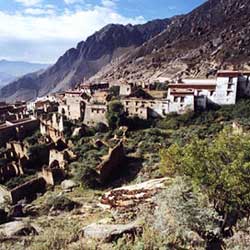
As the "Roof of the World," Tibet has long been a favored destination for tourists from around the world.
The mysterious Buddhist holy place was hidden from the outside world for thousands of years. For adventurers and traders it was a legendary land of treasure and riches.
Located in the southwest of China, Tibet Autonomous Region has changed very rapidly both in its economy and tourism development. An airport now established in Lhasa has flights that can take visitors to and from many major cities like Beijing, Chengdu and Shanghai. A railway from Qinghai Province to Tibet is also under construction. After the completion of the Qingzang (Qinghai-Tibet) rail line, the trip to Tibet will be much easier.
Tibet is without doubt one of the most remarkable places to visit in Asia. It offers fabulous monastery sights, breathtaking high-altitude treks, stunning views of the world's highest mountains and one of the world's most grand peoples and cultures.
Religion here has a strong Tibetan cultural flavor, while keeping the original basic doctrines of Buddhism.
Tibetan Buddhism has a great influence in the daily life of the Tibetan people. There were many different schools of the Tibetan Buddhism in history.
From Lhasa, the capital of Tibet Autonomous Region, to the pastoral villages spread throughout the grasslands, there are many temples with golden roofs shinning under the sun.
Another important symbol of Tibetan Buddhism are the pilgrims who prostrate themselves every nine steps on their way from their hometowns to the holy city of Lhasa. Pilgrims can also be seen throughout Tibet visiting religious sites to erase their sins and accumulate virtue.
The monasteries are also the places where monks study Buddhism and where religion, art and customs have coalesced into one whole in Tibet.
The Shoton Festival, also known as Tibetan Opera Festival, is one of the major festivals in Tibet. Its origin is derived from a rule set by Tsongkhapa, the founder of the Gelug (Yellow Sect of Buddhism), which decreed that Buddhists should cultivate themselves only indoors during the summer, to avoid killing other creatures carelessly. This was because creatures are most active in summer. This rule must be carried out until the seventh lunar month. Then Buddhists go outdoors, accept yoghurt served by local people, and have fun. Generally summer is the best time to go to Tibet.
Usually, a visit to Lhasa will take at least a week or more. It depends how many places you want to go in Tibet. Here is a recommended itinerary for your choice.
Day 1: Arrive in Lhasa. Get accustomed to the high altitude by resting upon arrival. After a rest, visit Jokhang Temple and Barkhor Square. Stay overnight in Lhasa.
Day 2: Visit Potala Palace and Norbulingka. Stay in Lhasa.
Day 3: Visit Drepung Monastery in the morning and Sera Monastery in the afternoon. Stay in Lhasa.
Day 4: Take local bus (Lhasa-Tsetang) to the ferry terminal. Take ferry to Samye Monastery terminal (3 hours). After crossing the river, take the local truck or walk to the monastery. Visit the monastery and follow the same route back to the ferry terminal across the water. Take the same bus (Lash-Tsetang) or hitchhike on to Tsetang. Stay overnight in Tsetang.
Day 5: In the morning, hire a local pedicab for a whole day to go to Yumbulagang, visiting Trandruk monastery en route, and then head back to Tsetang. Take the local bus back to Lhasa in the afternoon (4 hours).
Day 6: Shopping in Lhasa and prepare for return trip.
To get there:
Flying is the most widely used means of transport to and from Tibet. There are flights to Lhasa from Chengdu, Beijing, Shanghai, Chongqing and Xi'an.
The ticket price between Beijing and Lhasa is about 2,000 yuan (US$247) for a one-way fare.
Summer is the peak time to visit Tibet. So book your air ticket four or five days in advance. If possible, buy the return ticket before starting your trip, which will avoid many inconvenient aspects while you are in Tibet.
While getting to Lhasa is straightforward, transport to some remote mountain areas or other isolated religious destinations may not be convenient. Public bus routes are not developed like those you see in Beijing. Renting a pedicab or a Land Cruiser from local travel agency is recommended. The price is judged by day.
Notes:
It is better to spend the first two or three days at least getting accustomed to the high altitude in Tibet. Don't exercise too strenuously for the first few days. Lhasa lies considerably above the altitude at which one's body begins to feel oxygen deficiency. Headaches, vomiting and heart palpitation are common ailments that appear in the first two or three days. Those with severe heart or chest problems should seek medical advice before going to Tibet.
Be sure to respect local customs and traditions when traveling.
Some Tibetans believe that taking their picture will harm their soul. It is best to ask for permission before taking pictures or filming any locals, especially the elderly.
Like the Lama Temple in Beijing, most Tibetan monasteries, especially larger ones, do not allow photography. Please pay attention to signs prohibiting photography. If you don't see any, assume they exist, or ask for permission before taking pictures.
As we described on page 4, Tibetan dogs are dangerous. Do not approach any stray or wild dogs you see and carry a stick if you plan to wander off on your own or at anytime after dark.
(China Daily August 5, 2005)
|

